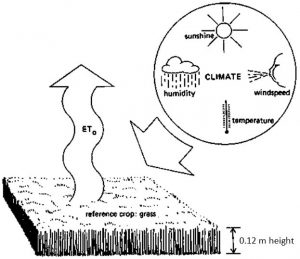ETo Reference Crop Evapotranspiration Explained.
 Evapotranspiration is the transfer of water vapour from plants, soil, land, water bodies, and other surfaces, to the atmosphere. Evapo refers to evaporation which is water transferring from soils and other surfaces. Transpiration refers to the amount of water leaving plants and vegetation. Combined, evapotranspiration is fundamental to the hydrological cycle.
Evapotranspiration is the transfer of water vapour from plants, soil, land, water bodies, and other surfaces, to the atmosphere. Evapo refers to evaporation which is water transferring from soils and other surfaces. Transpiration refers to the amount of water leaving plants and vegetation. Combined, evapotranspiration is fundamental to the hydrological cycle.
Evapotranspiration is difficult to measure directly. Elaborate, expensive, high precision scientific instrumentation is required to accurately measure evapotranspiration. Scientists have developed models, equations and algorithms that can estimate evapotranspiration. Currently, there are over 35 models that are used to estimate evapotranspiration. These models have been developed following decades of research and tens of thousands of publications. Rightly or wrongly, from this overwhelming amount of information, a single type of model is recognised as the standard for irrigation management, agriculture and horticulture: the Penman-Monteith FAO-56 reference crop evapotranspiration model – ETo.
What is Penman-Monteith FAO-56?
Penman and Monteith were independent scientists who developed evaporation or evapotranspiration equations in the 1940’s to 1960’s. In 1990, the United Nation’s Food and Agriculture Organisation (FAO) convened a meeting of experts who decided on a standard equation for evapotranspiration. The technical paper was given the number 56. Therefore, we have the Penman-Monteith FAO-56.
What is a reference crop?
 The reference crop refers to a standard surface from which evapotranspiration occurs. Prior to the concept of a reference crop, every surface (e.g. grass, wheat, macadamia, bare soil, etc) needed specific parameters. To simplify the equation, a reference, or standard, crop was defined as: “A hypothetical reference crop with an assumed crop height of 0.12 m, a fixed surface resistance of 70 s m-1 and an albedo of 0.23.” This type of crop is analogous to the grass at an airport alongside a runway, or in the rough of a golf course.
The reference crop refers to a standard surface from which evapotranspiration occurs. Prior to the concept of a reference crop, every surface (e.g. grass, wheat, macadamia, bare soil, etc) needed specific parameters. To simplify the equation, a reference, or standard, crop was defined as: “A hypothetical reference crop with an assumed crop height of 0.12 m, a fixed surface resistance of 70 s m-1 and an albedo of 0.23.” This type of crop is analogous to the grass at an airport alongside a runway, or in the rough of a golf course.
The real meaning of ETo
Consequently, ETo refers to the amount of evapotranspiration from a grass like field that is not limited by soil moisture or anything else. It is important to understand that ETo is a hypothetical amount of water transfer, or evapotranspiration, at a particular area at any time. The actual evapotranspiration, or crop water use, will certainly differ from ETo. For horticulture and agriculture applications, crop water use can be measured directly with the Implexx Sap Flow Sensor.
Millimetres and Inches – what does this mean?
ETo is expressed as millimetres (mm) or inches (in) per hour or day. Confusingly, mm and in are units of length so how are these related to water loss or evapotranspiration?
The FAO defines it as “the amount of water lost from a cropped surface in units of water depth.”
A mm is also defined as 1 litre of water per 1 m2 of ground area. So, an ETo of 1 mm per day means that 1 litre of water was transferred to the atmosphere from 1 m2 of ground or crop area.
Millimetres and inches can be converted and interchanged so interpretation can be made on the same units of measurement. Here are the conversions:
Millimetres (mm) = Litres / Area
Millimetres = 25.4*Inches
Inches = 0.0394*Millimetres
Area is the tricky parameter in these conversions. Area must be carefully defined otherwise confusion, and misinterpretation, over data can easily be made.
For example, as noted above, 1 mm (millimetre) of rainfall is defined as 1 litre of water per 1 m2 of ground. However, the Area parameter used in crop water use (also known as total sap flow or transpiration) may be canopy projection area, planting density, irrigation (dripper) area, basal trunk area, sapwood area, or total leaf area. There is no wrong use of these Area parameters and they all have their own importance. But these different definitions of Area are all defined as crop water use, transpiration, or crop evapotranspiration and the interpretation of the results will be vastly different. Therefore, when converting from millimetres or inches to litres, the Area must be carefully and consistently defined for meaningful analysis.
Evapotranspiration explained
